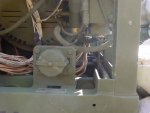reybo
New member
- 59
- 0
- 0
- Location
- Charlottesville, VA
Everything has been top notch with this mil gen. Run it for routine test every few months and it's been A-1.
Suddenly it isn't.
This weekend when I tried to start it, as I hit start there was a spark where the ground wire is close to the trailer bed, and thereafter a dead short between the 24v batteries and ground. (I had just checked and these were fully charged batteries.)
The ground wire was instantly -very- hot and the starter barely had enough current to turn over due to the short. It turned slowly but didn't spin.
The ground wire is only heated when the starter is engaged, not otherwise.
This unit is in a protected, covered area where neither rain nor wind can get to it. So it appears something to, from, or in the starter solenoid suddenly shorted.
Unless the generator is running, the batteries in this unit are disconnected from the motor by a knife switch. They are charged between runs by a 24v solar panel which has kept them charged very well. The knife switch has been open since the last test until being closed for today's test.
There's one other point. There is a small seepage of diesel fuel from the on-board tank. Very slight; no loss shown on the fuel gauge in 8 months. Just a wet trailer bed. But could that leak be above the starter or solenoid, and have soaked the windings?
Anyone had experience with this?
Suddenly it isn't.
This weekend when I tried to start it, as I hit start there was a spark where the ground wire is close to the trailer bed, and thereafter a dead short between the 24v batteries and ground. (I had just checked and these were fully charged batteries.)
The ground wire was instantly -very- hot and the starter barely had enough current to turn over due to the short. It turned slowly but didn't spin.
The ground wire is only heated when the starter is engaged, not otherwise.
This unit is in a protected, covered area where neither rain nor wind can get to it. So it appears something to, from, or in the starter solenoid suddenly shorted.
Unless the generator is running, the batteries in this unit are disconnected from the motor by a knife switch. They are charged between runs by a 24v solar panel which has kept them charged very well. The knife switch has been open since the last test until being closed for today's test.
There's one other point. There is a small seepage of diesel fuel from the on-board tank. Very slight; no loss shown on the fuel gauge in 8 months. Just a wet trailer bed. But could that leak be above the starter or solenoid, and have soaked the windings?
Anyone had experience with this?



